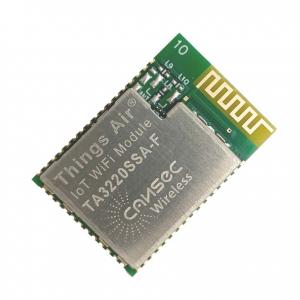Product Details
Support Transparent AT Command Wireless IoT Wifi Transmitter Module
Cansec TA3220SSA-F Ti CC3220 Switch Wifi Module
Parameter | Min | Typ | Max | Unit |
Current
Consumption | Sleep Mode(For Hibernate) | - | - | 9 | uA |
| Transmit Mode (@18dbm,for carrier) | - | 400 | 450 | mA |
TX Power (For Carrier) | - | 17 | 20 | dBm |
RX Sensitivity | - | - | -96 | dBm |
Distance | 190 | m |
Support Transparent AT Command Wireless IoT Wifi Transmitter Module
Cansec TA3220SSA-F Ti CC3220 Switch Wifi Module
1. TA3220S Module is designed based on TI’s CC3220S which is part of
the SimpleLink™ microcontroller (MCU) platform, which share a
common, easy-to-use development environment with a single core
software development kit (SDK) and rich tool set. A one-time integration of the SimpleLink platform enables you to
add any combination of the portfolio’s devices into your design,
allowing 100 per cent code reuse when your design requirements
change. For more information, visit Overview for SimpleLink™
solutions.
2. Start your Internet-of-Things (IoT) design with a Wi-Fi® CERTIFIED®
single-chip MCU System-on-Chip(SoC) with built-in Wi-Fi
connectivity. Created for the IoT, the SimpleLink™ CC3220x device
family from Texas Instruments™ is a single-chip solution,
integrating two physically separated, on-chip MCUs. • An application processor – ARM®
Cortex®-M4 MCU with a user-dedicated 256KB of RAM, and an optional
1MB of XIP flash. • A network processor MCU to run all Wi-Fi and
Internet logical layers. This ROM-based subsystem includes an
802.11b/g/n radio, baseband, and MAC with a powerful crypto engine
for fast, secure internet connections with 256-bit encryption.
3. The CC3220x wireless MCU family is part of the second generation of
TI’s Internet-on-a-chip™ family of solutions. This generation
introduces new features and capabilities that further simplify the
connectivity of things to the Internet. The new capabilities
including the following:
• Enhanced Wi-Fi provisioning • Enhanced power consumption
• Enhanced file system security (supported only by the CC3220S and
CC3220SF devices) Wi-Fi AP connection with up to four stations • More concurrently opened BSD sockets; up to 16 BSD sockets, of
which 6 are secure
• HTTPS support
• RESTful API support
• Asymmetric keys crypto library
• The CC3220x wireless MCU family supports the following modes:
station, AP, and Wi-Fi Direct®. The device also supports WPA2
personal and enterprise security. This subsystem includes embedded
TCP/IP and TLS/SSL stacks, HTTP server, and multiple Internet
protocols. The device supports a variety of Wi-Fi provisioning
methods including HTTP based on AP mode, SmartConfig™ Technology,
and WPS2.0.
• The power-management subsystem includes integrated DC-DC
converters that support a wide range of supply voltages. This
subsystem enables low-power consumption modes for extended battery
life, such as low-power deep sleep, hibernate with RTC (consuming
only 4.5 μA), and shutdown mode (consuming only 1 μA).
• The device includes a wide variety of peripherals, including a
fast parallel camera interface, I2S, SD, UART, SPI, I2C, and
4-channel ADC.
FAQ
Q1: Are you a factory or trade company?
A1: We are a professional factory with 25 years experience.
Q2: Can you accept OEM/ODM?
A2: Sure, we have rich OEM&ODM experience.
Q3: Do you have quality assurance?
A3; Each of our products has undergone quality testing and has two
years of free after-sales service.
Years ago, 802.11n introduced some exciting technologies that
brought massive speed boosts over 802.11b and g. 802.11ac does
something similar compared with 802.11n. For example, whereas
802.11n had support for four spatial streams (4×4 MIMO) and a
channel width of 40MHz, 802.11ac can utilize eight spatial streams
and has channels up to 80MHz wide — which can then be combined to
make 160MHz channels. Even if everything else remained the same
(and it doesn’t), this means 802.11ac has 8x160MHz of spectral
bandwidth to play with, vs. 4x40MHz — a huge difference that allows
it to squeeze vast amounts of data across the airwaves.
To boost throughput further, 802.11ac also introduces 256-QAM
modulation (up from 64-QAM in 802.11n), which basically squeezes
256 different signals over the same frequency by shifting and
twisting each into a slightly different phase. In theory, that
quadruples the spectral efficiency of 802.11ac over 802.11n.
Spectral efficiency is a measure of how well a given wireless
protocol or multiplexing technique uses the bandwidth available to
it. In the 5GHz band, where channels are fairly wide (20MHz+),
spectral efficiency isn’t so important. In cellular bands, though,
channels are often only 5MHz wide, which makes spectral efficiency
very important.
Company Profile
We are Beijing JiaAn Electronics Technology, founded in 1994;
Taiwan invested.
We are the third-party partner of Texas Instruments and the
supplier of Arrow Electronics;
along with over 25 years of experience in the RF industry,
we developed a team with deep technical background,
high performance and quick response timing to co-operate with our
clients globally.
About 70 per cent of our clients are overseas, and 80 per cent of
our clients are returning customers.
All our products require layers and layers of inspections, testing
and quality control procedures before shipping;
Offering our client a trustworthy and long-lasting partnership.



